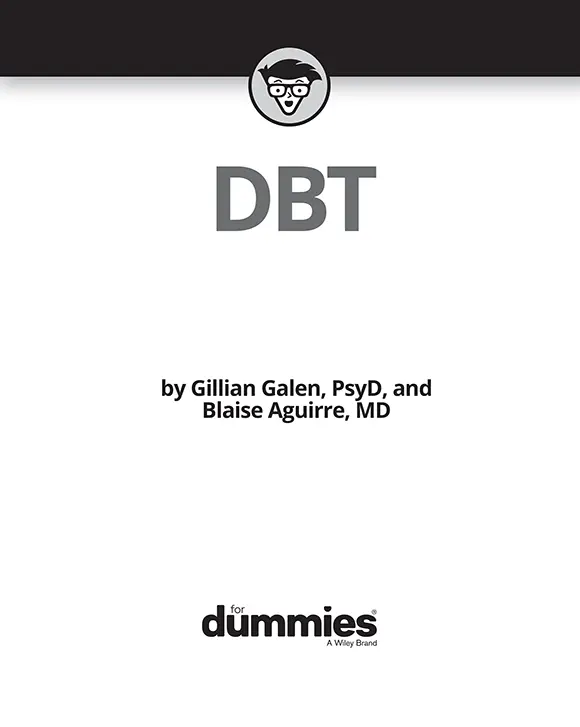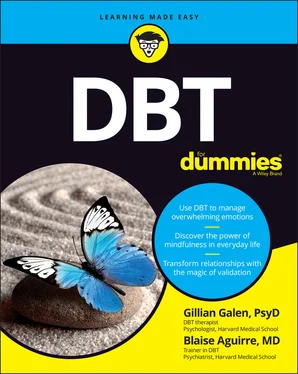
DBT For Dummies®
Published by: John Wiley & Sons, Inc.,111 River Street, Hoboken, NJ 07030-5774, www.wiley.com
Copyright © 2021 by John Wiley & Sons, Inc., Hoboken, New Jersey
Published simultaneously in Canada
No part of this publication may be reproduced, stored in a retrieval system or transmitted in any form or by any means, electronic, mechanical, photocopying, recording, scanning or otherwise, except as permitted under Sections 107 or 108 of the 1976 United States Copyright Act, without the prior written permission of the Publisher. Requests to the Publisher for permission should be addressed to the Permissions Department, John Wiley & Sons, Inc., 111 River Street, Hoboken, NJ 07030, (201) 748-6011, fax (201) 748-6008, or online at http://www.wiley.com/go/permissions .
Trademarks:Wiley, For Dummies, the Dummies Man logo, Dummies.com, Making Everything Easier, and related trade dress are trademarks or registered trademarks of John Wiley & Sons, Inc., and may not be used without written permission. All other trademarks are the property of their respective owners. John Wiley & Sons, Inc., is not associated with any product or vendor mentioned in this book.
LIMIT OF LIABILITY/DISCLAIMER OF WARRANTY: THE CONTENTS OF THIS WORK ARE INTENDED TO FURTHER GENERAL SCIENTIFIC RESEARCH, UNDERSTANDING, AND DISCUSSION ONLY AND ARE NOT INTENDED AND SHOULD NOT BE RELIED UPON AS RECOMMENDING OR PROMOTING A SPECIFIC METHOD, DIAGNOSIS, OR TREATMENT BY PHYSICIANS FOR ANY PARTICULAR PATIENT. THE PUBLISHER AND THE AUTHOR MAKE NO REPRESENTATIONS OR WARRANTIES WITH RESPECT TO THE ACCURACY OR COMPLETENESS OF THE CONTENTS OF THIS WORK AND SPECIFICALLY DISCLAIM ALL WARRANTIES, INCLUDING WITHOUT LIMITATION ANY IMPLIED WARRANTIES OF FITNESS FOR A PARTICULAR PURPOSE. IN VIEW OF ONGOING RESEARCH, EQUIPMENT MODIFICATIONS, CHANGES IN GOVERNMENTAL REGULATIONS, AND THE CONSTANT FLOW OF INFORMATION, THE READER IS URGED TO REVIEW AND EVALUATE THE INFORMATION PROVIDED IN THE PACKAGE INSERT OR INSTRUCTIONS FOR EACH MEDICINE, EQUIPMENT, OR DEVICE FOR, AMONG OTHER THINGS, ANY CHANGES IN THE INSTRUCTIONS OR INDICATION OF USAGE AND FOR ADDED WARNINGS AND PRECAUTIONS. READERS SHOULD CONSULT WITH A SPECIALIST WHERE APPROPRIATE. NEITHER THE PUBLISHER NOR THE AUTHOR SHALL BE LIABLE FOR ANY DAMAGES ARISING HEREFROM.
For general information on our other products and services, please contact our Customer Care Department within the U.S. at 877-762-2974, outside the U.S. at 317-572-3993, or fax 317-572-4002. For technical support, please visit https://hub.wiley.com/community/support/dummies .
Wiley publishes in a variety of print and electronic formats and by print-on-demand. Some material included with standard print versions of this book may not be included in e-books or in print-on-demand. If this book refers to media such as a CD or DVD that is not included in the version you purchased, you may download this material at http://booksupport.wiley.com . For more information about Wiley products, visit www.wiley.com .
Library of Congress Control Number: 2021935362
ISBN 978-1-119-73012-5 (pbk); ISBN 978-1-119-72567-1 (ebk); ISBN 978-1-119-73016-3 (ebk)
DBT For Dummies®
To view this book's Cheat Sheet, simply go to www.dummies.comand search for “DBT For Dummies Cheat Sheet” in the Search box.
Table of Contents
1 Cover
2 Title Page
3 Copyright
4 Introduction About This Book Foolish Assumptions Icons Used in This Book Beyond the Book Where to Go from Here
5 Part 1: The Nuts and Bolts of DBT Chapter 1: Entering the World of DBT Looking at the Main Pillars of DBT Getting an Overview of DBT’s Treatment Modes and Functions Focusing on the DBT Theoretical Framework Checking Out the DBT Stages of Treatment Surveying DBT Skills Walking through the Mechanics of DBT Treating Specific Conditions with DBT Chapter 2: Understanding Dialectical Behavior Therapy Beginning with the Biosocial Theory Focusing on the Functions and Goals of a Comprehensive Treatment Checking Out Modes of Treatment Incorporating Dialectics Chapter 3: Accepting Multiple Points of View Questioning Your First Reaction Expanding Your Perception Looking at Yourself with Friendly Eyes Chapter 4: Moving from Impulsive to Spontaneous Distinguishing Impulsivity and Spontaneity Moving Beyond Your First Reaction Opening Up Transforming Negatives into Positives
6 Part 2: Gaining Understanding Chapter 5: Understanding Your Emotions Recognizing How You’re Feeling Confronting Disproportionate Reactions Identifying and Handling Problem Areas Chapter 6: Understanding Your Behaviors Being Aware of How Your Emotions Manifest in Action Identifying and Handling Emotional Triggers Tying Specific Behaviors to Specific Reactions Chapter 7: Understanding How You Think Tapping into Your Self-Talk Looking at Your Reactions Chapter 8: Understanding Your Relationships Recognizing Relationship Dynamics Enhancing Communication Making Room for More Possibilities
7 Part 3: Exploring DBT Skills Chapter 9: Thinking about Mindfulness Exploring Your Own Mind Understanding Types of Mindfulness Realizing the Benefits of Mindfulness Chapter 10: Regulating Your Emotions Turning the Keys of Emotion Regulation Being Your Own Emotional Support Chapter 11: Building Your Distress Tolerance Managing Difficult Moments with Crisis Survival Skills Recognizing That Everything Has a Cause Curbing Impulsive Behavior Doing Your Own Crisis Management Chapter 12: Increasing Your Interpersonal Effectiveness Before You Begin: Being Aware of Obstacles Mastering the DEAR MAN Skill Practicing the Art of Validation Communicating with GIVE Skills Staying True to Yourself with the FAST Skill Combining GIVE and FAST Putting It All Together Chapter 13: Walking the Middle Path Finding the Balance Embracing Cooperation and Compromise
8 Part 4: The Mechanics of DBT Therapy Chapter 14: Exploring Therapy Basics One on One: Individual Therapy All Together: Group Therapy Time to Connect: Phone Coaching Chapter 15: Embracing Dialectics In the Beginning: Stumbling onto Dialectics Thinking Dialectically Looking at the Main Dialectical Dilemmas Tackled in Treatment The Dialectical Dilemmas of Parenting: Walking the Middle Path Understanding Therapist Dialectical Interventions Chapter 16: Structuring the Environment Adding Structure to Two Different Environments Addressing a Problem in Five Ways Building a Framework Structuring Individual Sessions Putting Structure in Different Contexts Chapter 17: The Therapist Consultation Team Joining a Consultation Team Sticking to the Agenda Chapter 18: Tracking Your Experience Keeping a Daily Diary Card Analyzing Your Behavior Chapter 19: Gaining and Keeping Motivation Having Motivation for Therapy Increasing Motivation Maintaining Motivation
9 Part 5: Putting DBT into Action for Specific Conditions Chapter 20: Building Mastery for Mood and Personality Disorders Addressing Borderline Personality Disorder Managing Your Moods Alleviating Anxiety Chapter 21: Taming Trauma Understanding the Basics of DBT PE DBT-PTSD: Exploring an Alternative Model Digging into the Dilemma of Dissociation Chapter 22: Tempering Addictions A Word about Dopamine Working through Substance Dependence Overcoming Eating Disorders Gaining Ground on Body Dysmorphic Disorder Getting a Grip on Behavioral Addictions Chapter 23: Dealing with Counterproductive Behaviors Tackling Self-Invalidation Handling Self-Hatred Balancing Solitude and Connectedness
10 Part 6: The Part of Tens Chapter 24: Ten Mindful Practices Observe an Itch Observe the Urge to Swallow Observe Your Hands Observe Your Breath by Ladder Breathing Describe a Social Media Post Describe a Difficult or Painful Emotion Describe the Sounds around You Participate in Standing on One Foot Participate in Writing with Your Non-Dominant Hand Participate in Driving a Car Chapter 25: Ten Ways to Live an Antidepressant Life Engaging in Exercise Trying Meditation Eating a Less Refined Diet Being Careful with Alcohol and Various Drugs Getting Enough Sleep Maintaining Social Interaction and Connection Adding Recreation and Relaxation to Your Routine Accessing Green Space and the Environment Taking Care of Pets and Other Animals Making Time for Faith and Prayer Chapter 26: Ten Myths about DBT Myth: DBT Is Used Only with People with Borderline Personality Disorder Myth: DBT Therapists Teach Skills from a Manual; It’s Not a Real Therapy Myth: DBT Takes Years Before You Feel Better Myth: DBT Is a Suicide Prevention Therapy Myth: If No Other Therapy Has Helped,
Читать дальше













